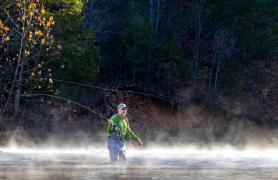Got a question for Ask MDC? Send it to AskMDC@mdc.mo.gov or call 573-522-4115, ext. 3848.
Q: I found this little guy while mushroom hunting. What type of moth is this?
Based on the size and color, this moth is likely to be an imperial moth (Eacles imperialis). At this stage in its life, the moth is waiting for its wings to dry and unfold. It still has its hemolymph — a fluid equivalent to blood in invertebrates — in its abdomen, but the fluid slowly will be pumped into its wings. When complete, its wingspan will be 3¾ to 5½ inches.
Found through the eastern United States, imperial moths emerge before sunrise and mate after midnight the next day. Females lay eggs at dusk singly or in small groups of two to five on the leaves of trees. The eggs hatch in about two weeks. These caterpillars are solitary feeders, often eating the leaves of maples, sycamores, and sassafras.
But as members of the giant silk moth family, the mouthparts of the adult moths are not functional, and they do not live long in the winged form.
Q. I had an American crow in one of my trees, and it was mimicking a turkey hen’s yelp. Is this common among crows?
Known for being both highly intelligent and very social, American crows can make up to 250 different types of vocalizations — caws being among the most common. But they are excellent mimics and can replicate a host of different sounds, including the calls of other birds and human speech. They also produce vocalizations that sound like cats, dogs, and geese.
Q. I was crossing a creek during turkey season when I saw something upstream bobbing towards me. It was a three-toed box turtle. It had its head and legs out, just floating along. Do turtles swim?
Although three-toed box turtles are considered a terrestrial species, they can swim and are known to float across a waterbody’s surface. For more information about three-toed box turtles, visit short.mdc.mo.gov/4QJ.
Q. Last May we spotted this full-grown bird. However, we could not find the species in our identification book. Can you identify it?
This is a great crested flycatcher (Myiarchus crinitus). These insectivores forage from high, exposed perches in tall trees that offer an unobstructed view of insects passing by and clear airspace for catching them.
They’re usually seen in forests, woodlands, and wooded parks. This is an edge-dwelling species — they prefer places where wooded areas adjoin grassy places. Therefore, anything that creates openings in the woods increases habitat for this species.
For more information, visit short.mdc.mo.gov/4QU.
Also In This Issue

Conserving important areas so diverse life can flourish

Handmade bamboo fly rods combine art and fishing
And More...
This Issue's Staff
Editor - Angie Daly Morfeld
Associate Editor - Larry Archer
Photography Editor - Cliff White
Staff Writer - Kristie Hilgedick
Staff Writer - Joe Jerek
Staff Writer – Dianne Van Dien
Designer - Shawn Carey
Designer - Marci Porter
Photographer - Noppadol Paothong
Photographer - David Stonner
Circulation - Laura Scheuler






















